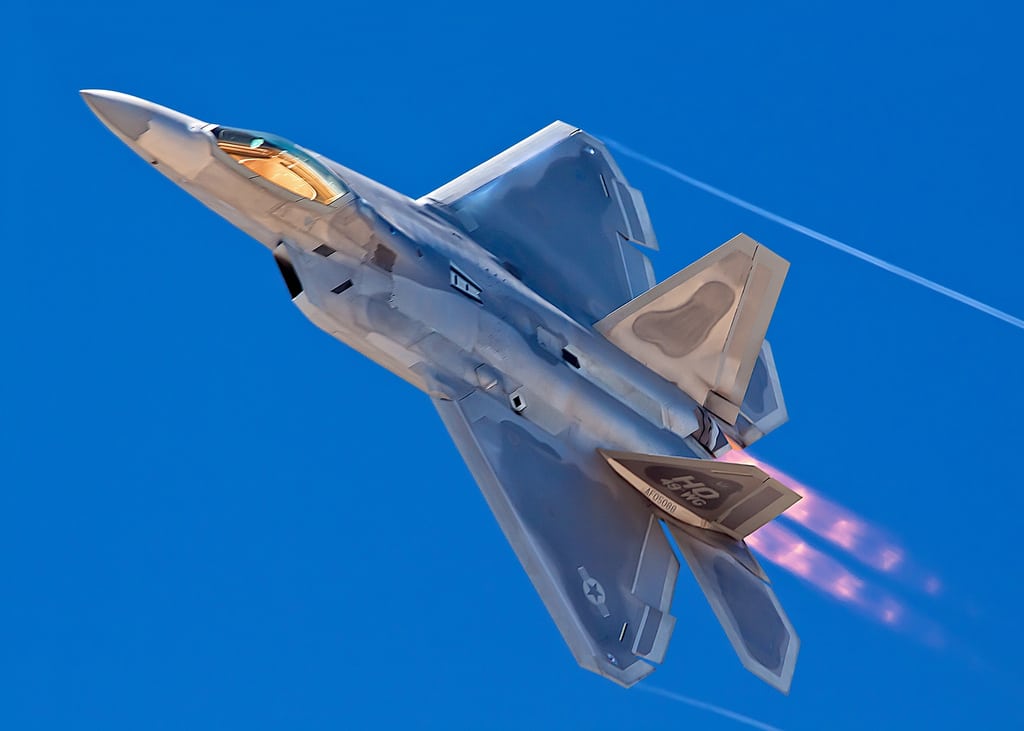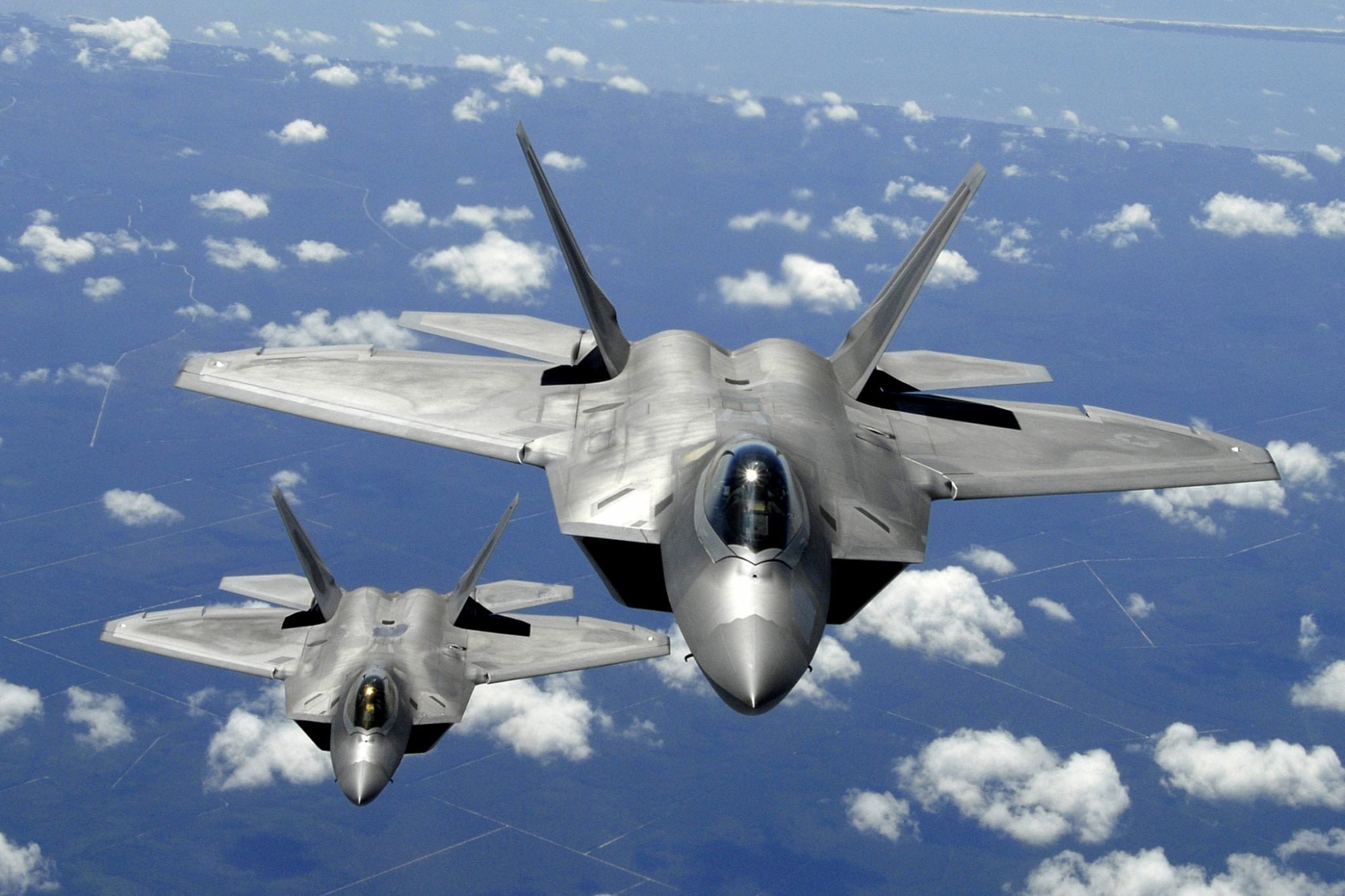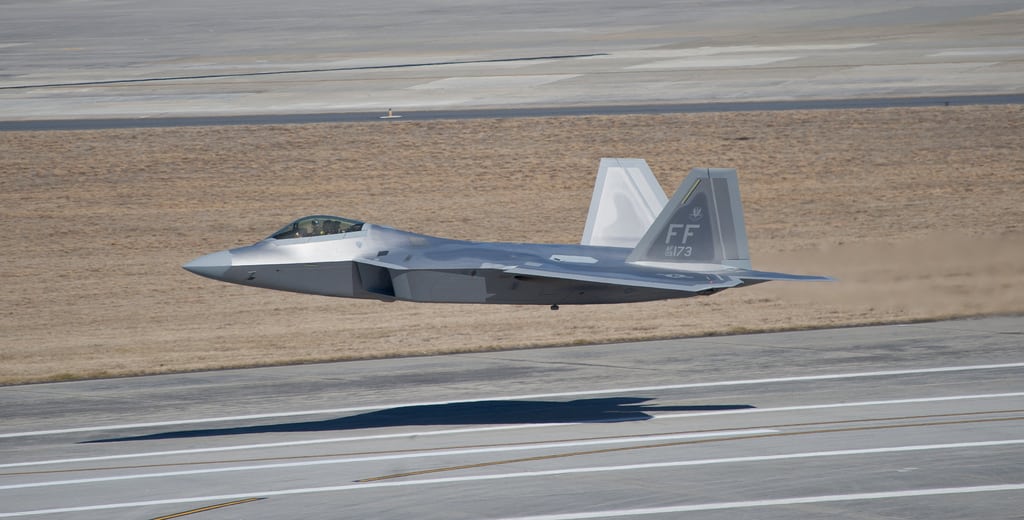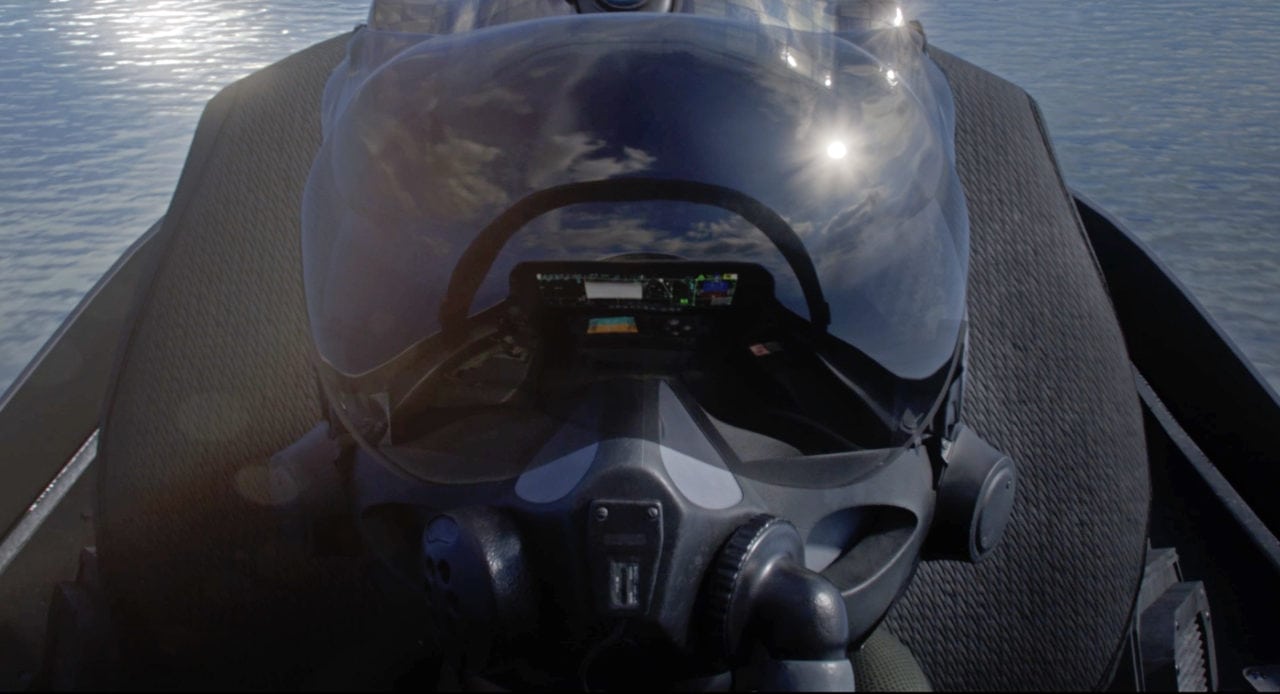
Lockheed Martin [LMT] is renovating the F-22 Raptor to catch the 15-year-old jet up with current technology. Beginning in May 2019, the company will be extensively modernizing the 186 in-service Raptors, for which President Trump’s fiscal year 2019 budget allocates nearly $1 billion dollars.
The first step is a tandem update of hardware and software, respectively called increment 3.2B and update 6. Ken Merchant, Lockheed Martin’s VP for the F-22 Program, told sister publication Avionics in an August interview that should take about three years of rolling 60-day upgrades to finish fleet-wide because “that’s what (Air Combat Command) is willing to give up operationally.”
Increment 3.2B comprises geolocation improvements to help provide information during cooperative engagements, as well as the integration of AIM-9X Sidewinder short-range air-to-air missiles, which include symbology links to pilot helmet displays for improved targeting and AIM-120D Advanced Medium-Range Air-to-Air Missiles. Merchant said that program has gone through full developmental and operational testing and was recently approved for production.
Update 6 is primarily a software upgrade. It also incorporates “some crypto gear” to improve the F-22’s cryptography capabilities that is undergoing developmental testing at California’s Edwards Air Force Base, slated for completion later this year, but further details about that are classified. Beyond that, update 6 features stability fixes for a number of avionics systems “so that a lot of the things we developed workarounds for in earlier releases we’re actually fixing in this release,” Merchant said.
An important, high-level goal for the program is to re-align hardware and software updates. Currently, there are separate alphanumerical (3.2B) and numerical (update 6) updates going on in parallel for the Raptor. The goal is to align to a single-code baseline — Merchant compares it to what Apple [AAPL] does with an iPhone.
“The intent is to get out of this mode where, ‘Oh I’m focused on Update 6, but you’re doing 3.2B in parallel, and you just change something in 3.2B and then I’ve got to change my baselines,’” he said.
The current method of update deployment also slows things down; if part of an update is being developed for 3.2B because of the planned schedule but is ready sooner, it can’t be deployed sooner because it isn’t compatible with the 3.1 baseline. That’s why 3.2B and update 6 are being deployed simultaneously. The new method aims to allow more agility in deploying minor upgrades when they are ready between the major updates. Lockheed Martin and the U.S. Defense Department are also structuring contracts to facilitate that flexibility.
“I couldn’t take a function from 3.2A or 3.2B and … field it before the whole 3.2B fielded if it was ready and proven in my lab because the contract forced me to do everything at the end of the program in one big bang,” Merchant said.
So, in the same way that Apple releases a large, network-wide operating system upgrade periodically, Lockheed Martin plans to release large updates perhaps annually with a smaller update in the off six months for stability fixes that won’t alter the code baseline, unlike current minor software updates. As such, any capability upgrades can be added as they’re ready.
To accomplish all that and facilitate easier future upgrades, the first release of the new single-code baseline will drop in the spring of 2019 as update 6 and increment 3.2B are implemented.
Still, Merchant said they might want to keep feature additions to an annual or bi-annual schedule to cut down on time pilots need to spend in simulators learning new things.

Crucial to the F-22’s role as a fifth-generation fighter is its ability to quarterback a mission with a group of fourth-generation fighters. For example, Merchant said, typically the military won’t send a group of F-15s, -16s or -18s forward into Syria without two Raptors in the flight.
To that end, the F-22 will be receiving Link 16 transmit and Mode 5 identify friend-or-foe capabilities, allowing it to share the data it collects with other allied forces like the F-35 does.
“Today, that’s typically done through voice comms,” Merchant said. “That’s obviously not something you want to be doing, even over secure channels. … (The upgrade) will give us the ability to talk to other platforms to include the F-35.”
The U.S. Air Force’s F-22 Program Office identified the move from voice communication to Link 16 as significant for the reduction in pilot workload it would provide.
There had once been talk of equipping F-22s with a multifunction advanced datalink (MADL) like the F-35 has. But as potential MADL upgrades to other programs have been canceled, there has been less reason to make the switch, according to Merchant. As the standard, Link 16 benefits everyone, a sentiment that the F-22 Program Office echoed in an email last month.
“While a MADL capability on the F-22 would serve fifth-to-fifth-generation communication, the Link 16 datalink is more widely fielded, promoting greater information flow across joint and combined forces,” the F-22 Program Office said in an email. “The Air Force determined the best application of finite resources was to integrate Link 16 transmit onto the F-22, as it serves communication on both fourth- and fifth-generation aircraft.”
Currently, Raptors have a Link 16 receive box, but Lockheed Martin will replace it with a multi-function information distribution system-joint (MIDS-J) radio that is standard throughout the services. In addition to providing the transmit capability, the new radio is also open architecture, compatible with a lot of commercially available parts such as 3U-format rackmount servers that will save space. Additionally, if anything becomes outdated, Merchant said he can “replace it with another single-board computer instead of having to bring a new box onto the jet and qualify that box.”
These capabilities, which fall under the heading of “tactical mandates,” should be operational by 2020, two years sooner than originally scheduled.
With an eye to the future, the new rack also leaves slots for communications gear and power supplies that might be added in the future. Other boxes on the F-22 that are on Lockheed Martin’s radar for replacement include the communication, navigation and identification box and the core integrated processor.
“How many cell phones have you had in the last 10 years? Probably more than one,” Merchant said. “We’re doing the same thing with the airplane.”
Merchant said that contracts typically have required avionics to last the full life of a fighter, but that’s becoming less and less practical as it’s becoming easier and easier to provide software updates.
“I’ve got a Fitbit watch. I bought it a year and a half ago. It’s not a watch I’m going to hand down to my granddaughter,” he said. “But when we talk about airplane avionics, we tend to say, ‘I want 8,000-hour life out of that box because I don’t know if I’ll get the money to upgrade it later on.’ And that really limits our ability to upgrade the airplane in the future. With this open-system architecture now, it gives us that plug-and-play flexibility.”
Merchant said the F-22 is “good” on weight still with these changes because the new racks tend to be lighter, though it’s starting to get “a little bit limited on power” as capabilities are added. Certainly, with the goal of keeping the Raptor in service until 2060, more electrical power will be needed at some point.

In 2024, funding kicks in for sensor enhancements, a project that is expected to run for several years.
“What we’re looking for is a sensor to complement the radar that’s on the jet,” Merchant said.
There isn’t much detail available yet about upgrades that are still six years away, but he stressed that it goes back to the Raptor’s mantra of “first look, first shot, first kill.”
“I want to maintain that first-look capability and be able to get a shot off,” Merchant said. “So I need a target-quality track at extended ranges outside what my radar can do today.”
Lockheed Martin has already updated the displays on the F-22 some — they’re crisper now and better depict things like remaining missile load — but Merchant’s team is eyeing something bigger. “I’ve got six displays in the cockpit right now: three relatively large displays and three relatively small displays,” he said. “As part of the mid-life update, one of the things we’re going after is, can we really bring the F-35 display straight over?”
Merchant calls the F-35 display “essentially about a 40-inch television that is panoramic and the pilot can customize that display the way they want it.” If that display proves infeasible, the team is also looking at the F-18’s large-scale panoramic display to see if it’s ripe for integration, according to VP of Integrated Fighter Group Product Development Mike Cawood.
That’s indicative of a philosophy shift for Lockheed Martin. The company wants to align manufacturing where possible.
“If I can take a box off the F-35 and maybe repackage it to fit F-22 and take advantage of the faster processing speed, more memory, more cooling,” Cawood said. “Now I have an active repair line, an active production line. If I run short of spares, I can produce more.”
It especially makes sense to link the F-22 up to other programs as much as possible because it doesn’t have the unit numbers to support production in the way other programs do. There are 186 Raptors in service between trainers and combat aircraft. By the time its planned service life is over, the Defense Department already has designs on fielding 10 times that many F-35s.
The company is also going to see if it can do something to that effect with a new helmet for Raptor pilots. So far, it has upgraded to a Scorpion helmet-mounted display, which Merchant said is “basically just a reticle” that gives the ability to employ AIM-9X targeting by looking off axis.

“It takes some of the things off the (head-up display) and puts them on the visor, but it’s not as Gucci as the F-35 where I can see through the plane,” he said.
Next year, however, he expects a request-for-proposals from the Air Force for a more advanced helmet and he said “a toned-down version of the F-35 helmet may be an answer.”
The F-22 Program Office said that it “has not released specific requirements for a helmet-mounted display and cueing system to the industry” yet, but that the Air Force “will be looking for a helmet with usability over a variety of missions. This includes day and night cueing of sensors and weapons, such as the AIM-9X, at high off-boresight angles.” The ability to visually align objects rather than having to “manually correlate what is visible outside of the canopy with the aircraft’s displays” was also listed as a necessity as well as leveraging the evolution of technology to receive an advanced product at an affordable cost.
The F-35 gets a lot of attention given the program’s scope and cost. But Lockheed Martin hasn’t forgotten about its other fifth-generation fighter and neither has the military, which is determined to make good use of the fighter whose program had cost nearly $70 billion by the time of its cancellation in 2011.
The program office expects to see the two “flying together more often” thanks to their “unique access to more challenging airspace” as the F-35’s fleet presence continues to expand. That makes it all the more important that the Raptor catches up.